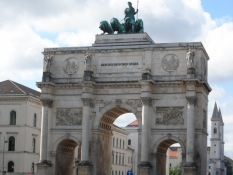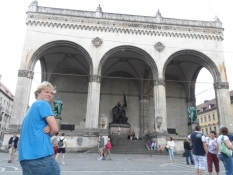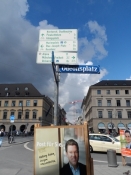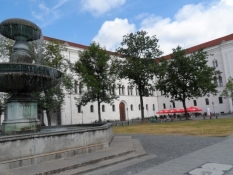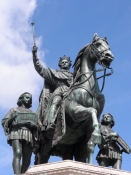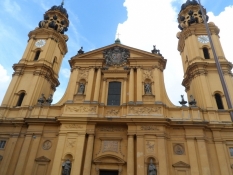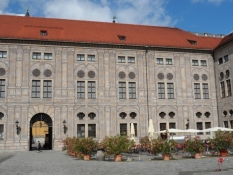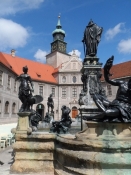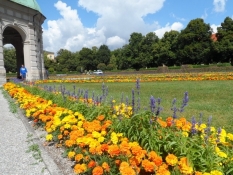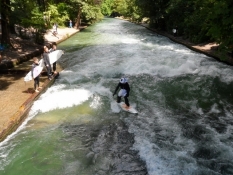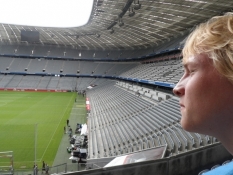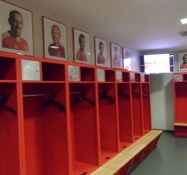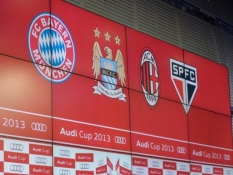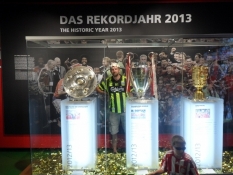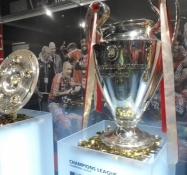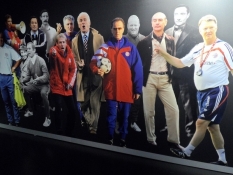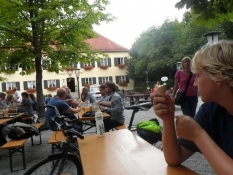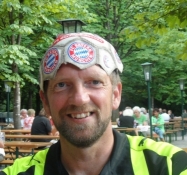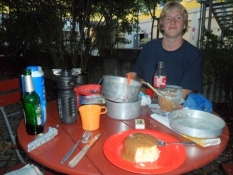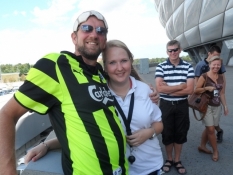Cycle Tour Tour in the Alps 2013
Dag 1: München, dag 1
![]()
Please wait - map data are loading
Added on 25 Aug 2013
last edited by Ottocolor on 28 Aug 2020
Cycle route metrics
ridden
Total distance in km
32
Cumulative elevation gain in m
232
Avg. slope uphill in %
0,73
Cumulative elevation loss in m
233
Min. height
496
Max. height
532
Information about rights to the gps-track data | |
|---|---|
Rights owner | |
Rights characteristic / license | by-sa: CREATIVE COMMONS Attribution-ShareAlike |
Link to the description of the license | |
GPX file uploaded | by Ottocolor on 25 Aug 2013
|
Track points in total
483
Track points per km (avg)
15
Start/endpoint
Start location
München, Bayern, DE (525 m NHN)
End location
München, Bayern, DE (525 m NHN)
ridden on
30 Jul 2013
Weather
In the morning overcast and one little shower, but later a fine day with comfortable temperatures of about 21-22 degrees. Weak winds.
Accommodation
Haus International
Elisabethstraße 87
DE-80797 München
Properties
Mostly bikepaths along the streets of Munich. On separate, signposted and tarmaced bikeways through the English Garden and Hirschau. Gravel path along the river Isar on a stretch to the stadium.
Sources of information
Bikeline-book "Bike atlas Munich", a city map, borrowed from TV 2 and a small city map from the hostel "Haus International"
Remarks
The first day of the "Tour in the Alps 2013", Tuesday, July 31st, was preceeded by two transport days. On Sunday, July 28th I picked Simon up at Billund Airport, where he had arrived with his mother from a short vacation in Portugal at about 7.30 pm. We then drove to a campsite near Egestorf, about 50 km south of Hamburg, where we slept in our tent. The next day, Monday, July 29th, we drove Susanne's mother's car, a VW Caddy, the remaining about 800 km to Munich, where we arrived in a heavy downpour at about 7.30 pm. After we had accommodated ourselves at the hostel Haus International, I drove the car to a hotel garage about 4,5 km away, where I had heard about a cheap and safe possibility to park the car, and went back to the hostel by bike. It was then time for a dinner, which we had at the restaurant Mediteranee in Elisabeth street not far from the hostel. We were now ready for our first night in Munich.
Travel report
Information about copyright | |
|---|---|
Rights owner | |
Rights characteristic / license | by-sa: CREATIVE COMMONS Attribution-ShareAlike |
Link to the description of the license | |
Image has been uploaded | by Ottocolor on 25 Aug 2013
|
Information about copyright | |
|---|---|
Rights owner | |
Rights characteristic / license | by-sa: CREATIVE COMMONS Attribution-ShareAlike |
Link to the description of the license | |
Image has been uploaded | by Ottocolor on 25 Aug 2013
|
Information about copyright | |
|---|---|
Rights owner | |
Rights characteristic / license | by-sa: CREATIVE COMMONS Attribution-ShareAlike |
Link to the description of the license | |
Image has been uploaded | by Ottocolor on 25 Aug 2013
|
Information about copyright | |
|---|---|
Rights owner | |
Rights characteristic / license | by-sa: CREATIVE COMMONS Attribution-ShareAlike |
Link to the description of the license | |
Image has been uploaded | by Ottocolor on 31 Aug 2013
|
Information about copyright | |
|---|---|
Rights owner | |
Rights characteristic / license | by-sa: CREATIVE COMMONS Attribution-ShareAlike |
Link to the description of the license | |
Image has been uploaded | by Ottocolor on 31 Aug 2013
|
Information about copyright | |
|---|---|
Rights owner | |
Rights characteristic / license | by-sa: CREATIVE COMMONS Attribution-ShareAlike |
Link to the description of the license | |
Image has been uploaded | by Ottocolor on 31 Aug 2013
|
Information about copyright | |
|---|---|
Rights owner | |
Rights characteristic / license | by-sa: CREATIVE COMMONS Attribution-ShareAlike |
Link to the description of the license | |
Image has been uploaded | by Ottocolor on 31 Aug 2013
|
Information about copyright | |
|---|---|
Rights owner | |
Rights characteristic / license | by-sa: CREATIVE COMMONS Attribution-ShareAlike |
Link to the description of the license | |
Image has been uploaded | by Ottocolor on 31 Aug 2013
|
Information about copyright | |
|---|---|
Rights owner | |
Rights characteristic / license | by-sa: CREATIVE COMMONS Attribution-ShareAlike |
Link to the description of the license | |
Image has been uploaded | by Ottocolor on 31 Aug 2013
|
After a good night's sleep at the hostel we went down to eat breakfast in the large cafeteria. There were many people, mostly young people, who all found something to eat. You could hear all sorts of languages in the queue. It was an excellent breakfast, which they self-assembled with both muesli and (slightly soft) rolls. Simon missed the apple juice, but otherwise there was nothing to complain about at the breakfast. While we ate, there was a heavy shower comind down. It had almost figured since we arrived in Munich, especially on the way into town by car, but the weather forecast promised improvement. We hoped for that, while we got ready at our room on the 2nd floor. The hostel seemed large and somewhat impersonal, but that is the nature of a big city.
The first few kilometers of the trips in Munich was completed on bike paths along the streets. They are quite narrow and the locals certainly felt we cycled too slow, because we were constantly overtaken, also on the right side, but one has to accept that, I guess. When we reached the great Leopold Strasse, we turned to the south and could already see the Triumphal Arch Siegestor. Before that we stopped shortly at Munich Maximilian University. I told Simon that here had the siblings Hans and Sophie Scholl and their co-conspirators in the resistance group the White Rose, shared their leaflets out in 1943 in protest against the Nazi regime, but had been discovered, arrested, interrogated, tried and executed in rapid succession. Simon had heard about but did not know it was happening at the university. The square in front of it is now called appropriately enough Geschwister - Scholl -Platz. Many German cities have a street or square with that name. You understand very well, why they like to pay tribute to these brave young people also to show that there still WAS anyone who resisted against Hitler's tyranny. 'Victory gate' I was pleased to look at it, because Bayern Munich feature it in the run-up to broadcasts from FCB - TV, where the triumphal arch is virtually dressed in red and white. Here on this boulevard, which to the south is called Ludwig Strasse after the king who built it, King Ludwig I, is a car convoy when Bayern Munich have won a trophy and go into the city from the stadium in an open bus. A whopping three times it had happened only shortly before, in May / June this year, when Bayern won both the German Championship, Champions League and German Cup, the DFB -Pokal. The three trophies we were going to see in the Bavarian museum later that day. But Siegestor obviously has nothing to do with Bayern Munich victories. It was built in gratitude to the Bavarian army's triumphs. During the bombing of 2 World War II it was badly damaged, and on the side facing the city the devastation is still to be seen. The inscription (in translation) is also appropriate: "Dedicated to victory, destroyed by war, admonishing to peace".
The weather had now cleared and the sun shone most of the rest of the day. The next stop was at the equestrian statue of King Ludwig I, which appropriately enough has named this street with its magnificent villas and upscale official buildings. It was then that Bavaria had become an independent nation in 1806 during the Napoleonic Wars, and the Royal family of the Wittelsbacher did everything to mark the greatness and not the least the difference to the Prussia to the north and the Austrians in the south, with whom it has always looked closely associated with. It's probably more Austrians who believe they don't have much in commen with the Bavarians. But things had to be splendid here in the royal city of Munich, and Simon and I saw examples of that several times during our three days in the city. So was Odeonsplatz, where we now had reached a very appropriate place to begin the sigthseeing on foot before it was time to ride out to the football temple Allianz Arena, where I had booked a guided tour for us at 1pm.
Odeonsplatz is named after a cinema, das Odeon, which no longer exists. It represents the culmination of Ludwig Strasse towards the center and marks the start of the extensive pedestrian street system. The square is framed by magnificent buildings. To the west the great Theatinerkirche in a yellow color with baroque domes. Simon asked if it was the cathedral. It says all about its prominent role. Opposite the church is none other than the royal residence, which was a royal winter palace while they lived out in the Nymphenburg in summer. The Bavarian kingdom existed from 1806 to 1918, sos only 100 years. Compared to the fact it is really incredible, so much pomp and circumstance, Munich has to offer. Residenz' facade to the square looks really something. First we went up the stairs of the notorious Feldherrnhalle, which ends the square to the south. This somewhat clumsy peristyle with Bavarian lions in front hase played a major role in history and has been a bone of contention. The purpose of its construction was also to honor the Bavarian Army's achievements. But the many wars that Bavaria and then the German Empire was involved in, resulted in many dead soldiers, which needed a place to be honored. And that became Feldherrnhalle. Not many know that the Bavarian Minister Montgelas' insistence to ally with the Austrians' archenemy France was very expensive, especially in human lives. E.g. it was primarily the Bavarian cavalry, who rode at the head of Napoleon's disastrous campaign against Moscow. So there was shed so much Bavarian blood in Russia. For the same reason one Adolf Hitler wanted that the coup d'etat, he and his few party supporters in the relatively newly formed Nazi party had started in Bürgerbräukeller on November 8th, 1923 on the other side of the Isar River the night before, was to end here in a march through the center of Munich. The city was in the early 20s a cheerful jumble of many aspiring existences, and the police was reportedly not as harsh here as in the capital Berlin. But Hitler's coup in German called The Bierstubenputsch, ended as we know, in a measly defeat, not least because the Bavarian police and army, yet chose not to support Hitler, but to break up the march, just here at Feldherrnhalle. It came to a shootout, which killed six Nazis and 14 armed police officers. Hitler himself was very little heroic. He escaped before the case was settled. This event was later blown up to something very big when Hitler came to power in 1933, and the place was almost sanctified with a day-and-night-guard of two SS men and a large memorial on the wall towards the residence. Here every citizen who passed the guard had the duty to greet with outstretched right arm, that Hitler salute. There was a short cut behind the Feldherrnhalle if you did not want to do it. For the same reason this tiny alley was called 'cowards alley'. Today, all traces of the monument are removed, even the foundation is gone. Simon let himself be photographed with the lions, which he thought looked good, but the lions are also the animals of his favourite football club at home in Denmark. Oh, if only every game was so peaceful as football, it may be felt even though football can also lead to violent struggles among the supporters. But it only very rarely ends with deaths.
We let the bikes now stand on the site to go forward to walking into the residence with its many beautiful courtyards. In the first yard, the emperor yard, all facades have completely smooth surfaces, but they are decorated with paintings in a way that will look like there are reliefs and pilasters on them. I guess it should look for more than there was money to. Simon wasn't impressed tremendously. That was the case, in turn, by a poster that showed the audience seats in the socalled Cuvillies theater, located here in the residence, which is one of the most beautiful and best preserved theaters from the Baroque period. Well, we did with admiring the poster and continued into the well yard, which really was incredibly beautiful with its huge fountain. Furthermore, it was quite quiet here and you sensed the place of greatness. There was put up a scene and chairs. The theater had probably moved its performances also in the summer, and I can not imagine a more romantic place to experience a classic play.
Well, romance is not what is paramount when you are together with Simon. Even so this impressed him anyway, I felt. In the next courtyard, the pharmacies courtyard, there was a big hole in the pavement, and Simon thought that they probably were building a subway station here. I laughed, for a station in the middle of one of the residence's splendid yards? No, it could not be. Out on the east side of the residence met one's eyes a large modern glass building. It turned out to be Max Planck Institute Department of Intellectual Property Rights. What a difference that was. Our path went up in the palace garden, called Hofgarten in German. It was pleasantly cool among the plane trees that already seemed autumnal. We stood for a while looking over a fence down to yet another war memorial, which is now the official in Munich to commemorate the fallen of both world wars. It is made in the form of a giant stone slab over two rows of stone pillars. Beyond it stands an imposing building, which is now the Bavarian government's building, Staatskanzlei. The fact is that the 16 German states have their own state government, Bayern consider themselves even as a 'commonwealth', the Free State of Bavaria. But one should not put too much into that. Germany is a federation and with German thoroughness the competence between the federal government in Berlin and the State Governments is clearly defined. Whether you are a 'commonwealth' or not. But it sounds good. And a giant colossus of a government building helps well also on its own reputation. Previously it was the army museum, but after big devastations under the war it changed its function. One can also look at it that architects today love glass facades, for such a thing has been put on the outside of the old stone facade. Well, we turned our backs to the colossus and went into the palace garden. Here fell the beautiful flower arrangements, arranged in lines towards the round Diana Temple in the middle of the eyes. Inside the temple with open sides sat a group of adult artists and painted what they saw. And they saw many different things, I found.
Time had run and we had better find our bikes on Odeonsplatz and cycle the approx. 11 km up to the Allianz Arena. We also had to find the way out there.
Information about copyright | |
|---|---|
Rights characteristic / license | by-sa: CREATIVE COMMONS Attribution-ShareAlike |
Link to the description of the license | |
taken over / edited on | 18 Nov 2013 - 28 Aug 2020
|
taken over / edited by |
|
Information about copyright | |
|---|---|
Rights owner | |
Rights characteristic / license | by-sa: CREATIVE COMMONS Attribution-ShareAlike |
Link to the description of the license | |
Image has been uploaded | by Ottocolor on 26 Aug 2013
|
Information about copyright | |
|---|---|
Rights owner | |
Rights characteristic / license | by-sa: CREATIVE COMMONS Attribution-ShareAlike |
Link to the description of the license | |
Image has been uploaded | by Ottocolor on 26 Aug 2013
|
Information about copyright | |
|---|---|
Rights owner | |
Rights characteristic / license | by-sa: CREATIVE COMMONS Attribution-ShareAlike |
Link to the description of the license | |
Image has been uploaded | by Ottocolor on 26 Aug 2013
|
Information about copyright | |
|---|---|
Rights owner | |
Rights characteristic / license | by-sa: CREATIVE COMMONS Attribution-ShareAlike |
Link to the description of the license | |
Image has been uploaded | by Ottocolor on 01 Sep 2013
|
Information about copyright | |
|---|---|
Rights owner | |
Rights characteristic / license | by-sa: CREATIVE COMMONS Attribution-ShareAlike |
Link to the description of the license | |
Image has been uploaded | by Ottocolor on 01 Sep 2013
|
Information about copyright | |
|---|---|
Rights owner | |
Rights characteristic / license | by-sa: CREATIVE COMMONS Attribution-ShareAlike |
Link to the description of the license | |
Image has been uploaded | by Ottocolor on 01 Sep 2013
|
Information about copyright | |
|---|---|
Rights owner | |
Rights characteristic / license | by-sa: CREATIVE COMMONS Attribution-ShareAlike |
Link to the description of the license | |
Image has been uploaded | by Ottocolor on 01 Sep 2013
|
Information about copyright | |
|---|---|
Rights owner | |
Rights characteristic / license | by-sa: CREATIVE COMMONS Attribution-ShareAlike |
Link to the description of the license | |
Image has been uploaded | by Ottocolor on 01 Sep 2013
|
Information about copyright | |
|---|---|
Rights owner | |
Rights characteristic / license | by-sa: CREATIVE COMMONS Attribution-ShareAlike |
Link to the description of the license | |
Image has been uploaded | by Ottocolor on 01 Sep 2013
|
It is not difficult to find your way around Munich by bike, for everywhere there are green bike signs with kilometer indication. At Odeonsplatz it said already Arena 11 km. It doesn't say, of course, Allianz Arena on the signs, as the insurance company Allianz has only bought the rights to the name for a certain number of years (which later turned out to be no less than 30 years!). In that case they had to make all the signs anew. And it turned out jolly well that the route was signposted all the way through the huge park of Englischer Garten and beyond it through Hirschau the entire tortuous path to the stadium. Well, I had chosen a different route into the English Garden. On the way we saw many election posters throughout the city. Beside the national election on September 22nd, there was also to be held state elections, that is, to the Bavarian Landtag (the German states called Länder, countries. A name, which may cause misunderstandings in other languages.). And even more there was to be an election of Munich's city council. So there was enough to be aware of for the inhabitants. Simon noted that the so-called Bayernpartei apparently was separatist and wanted Bayern out of the Federal Republic of Germany. And I had to agree with him. Incredibly so. I smiled a little to myself at a poster with Florian Post from the SPD. "Post für Sie" (Post for you) it said. Funny.
We cycled along the ring road, which here is called Von-der-Tann-Ring and then along the magnificent Prinzregentenstraße. Here we looked short at the Haus der Kunst, one of the few buildings remaining from the Nazi time. It is just as pompous as you imagine Hitler would build here in what he called the Nazi movement's capital. The fact that Munich has 'always' been an important center of art also makes it no less impressing. But we didn't offer the colossus many glances but crossed the street to admire the surfers on Eisbachwelle instead. Here, the surfers themselves had created a phenomenal surge in the rapid stream of the Eisbach. They stand in line at one bank with their board under the arm, and then when it is one's turn, he or she rolls it out into the wave and does tricks and tries to stay on his feet as long as possible until it's time to let the next in the queue get a few seconds of fame. They just let themselves plunge into the water and take their board a little further down the stream. In such hot weather as this day it must be a6 pleasure, but they do it supposedly all year round. Brr ! Well, now we had to get a move on the bikes if we were to be at the stadium in time for the tour, and it was indeed a wonderful trip with all bike signs. And there were not many pedestrians on the wide paved path, so it went well northwards. Slightly slower we went past the beer garden Chinesischer Turm, probably the biggest of them all. But there were no drunks to be seen just incredibly many incredibly thirsty people under the trees. Soon we were at another beer garden, where my friend Kolja and I had enjoyed coffee and beer at one of the first spring days in early March. Here we crossed the ring road through a tunnel, and we were now in the outer part of the English Garden, which is called Hirschau. The bike path was almost a cyclostrada (my personal favourite term for super bike paths) here and there were still signs for the arena. Suddenly it ended, and just now the temptation could not be bigger, as the path lead directly into another splendid beer garden, called Aumeister. I promised myself that here we should pause on the way back ! Simply just fabulous with all that beer culture. Right now there was no time for that. While we were a little confused about where the path continued on the other side of the beer garden, a little shower came down, while we waited under a road bridge. I was now keen to bike on the Isar bike path and cycle along the river. We found it without problems, but the path was in a somewhat worse condition with many bumps. But it was great to cycle along the river, which flows quickly across large gravel banks. There had to be a canal on the other side of it, because here one could not sail in other things than on a raft or rafting boat. Well, we found out of the woods in the right place and the Freisinger Landstraße. On the other side stood a huge wastewater treatment plant, which did not smell very well. Then came a highway bridge, and then opened the prospect of a futuristic stadium, which stands like a spaceship on a landing pad next to the highway junction system. But we just parked our bikes at a wall and hurried into the stadium for the meeting point of the guided tours. We arrived in good time and the point was easy to find using the TV screens. I had booked the English tour, so Simon could understand better. Therefore, there were many nationalities in our group, including other Danes. I was praised for my hat, which consists of half a football. Later, in the fan shop, I would buy Bayern-stickers and decorate it. Our guide was a young woman who spoke rather poor English, but when she had said everything a million times, you could certainly understand her. The atmosphere was a little dull, but when we sat in the stands, we would all shout 'goal' so loud we could (I cried 'Tor', as they do here), and that lifted the spirits. Also we learned one funny thing about the lawn care with artificial sunlight in winter, the special player entrance to the stadium, which can fold up before and after the game and during the halftime break. It also has a special small door which may be opened during the match, in order to let sent off players to go to the dressing room immediately. It was also fun to hear about the press seats and galleries. There was something about 158 years of queuing to rent a similar business gallery... Well, there was some boasting and also a little understated arrogance in the guide's words, but that belongs to Bayern Munich too. They simply know that they are good. And everybody, who doesn't support the club is so well and truly tired of it, so Bayern is probably one of the most hated clubs in the world. But Simon and I love them, and take a like in the pompous details. It continued in the press room, which, of course, is very large and ultra-modern. Among other things, there is an interpreter box, so that press conferences can be interpreted into an incredible number of languages. The whole world is interested in the words of director Rummenigge, president Hoeness and especially the newly appointed coach Josep ' Pep ' Guardiola into the microphones. The four club logos for AC Milan, Manchester City FC, FC São Paulo and of course FC Bayern Munich were listed on the whiteboard. Those were the clubs in the Audi Cup 2013. Simon and I were to see them in action in the semi-finals the following day. I look regularly at Bayern press conferences at FCB TV on my computer. So it was fun to be in the same room. We also saw the catacombs beneath the stadium with locker rooms and wellness arena of Bayern and the away teams. The German national team does not use the Bayern facilities as one might suppose, but those of the away team. The reason for that I have forgotten. But it looked neatly everywhere. It was also fun thinking that Bayern has a very young Danish lad, Pierre Emil Højbjerg, in the staff. He comes from Brondby, and reportedly has the potential to be incorporated into the first team squad shortly. A place in the locker room he has not been given yet, I found. It's a long way to the top, but if you're inside the club, Bayern indeed is a faulous club to be in. Where else can you win three trophies ("Das Triple") in one season? But it requires definityely an extraordinary patience of such a young man. Plus, you surely must feel the aura around the stars. Honorary president Franz Beckenbauer is the personification of this, I think. After a look at the special player entrance, which allegedly had been Uli Hoeness' special wish, from the inside, we went for a walk around the stadium from the outside. Here are placed a lot of plexiglass "pads" that can light in three different colors when it's dark, so that the stadium appears either completely red (when Bayern plays), blue (when 1860 Munich plays) and white when the German national team plays at home here. On the other side of the highway you can see Fröttmaninger Berg. It is a large hill of accumulated rubble after the Second World War's destroyed buildings. Today it is a recreational area. Without all these highways it could certainly be as idyllic in the hills. Now it was time to say goodbye to our guide. I got a picture with her first.
After the guided tour we had grown hungry, so we lined up in the lengthy queue at the buffet with Bavarian food as Leberkäs - Semmel and Brezn. Here I heard Finnish and talked a little Finnish with a family from Mikkeli in Finland. At the bar it was time for the day's first beer. For Simon I bought a so-called 'Russian', but he did not like it. It is a mix of weissbier with lemon water. He preferred rather have a different mixture. Without beer, namely mezzo mix, which consists of cola and lemon water. After lunch it was time to embark on yet another attraction at the Allianz Arena (or Arroganz Arena as Bayern- haters like to call this modern football temple), namely Bayern Erlebniswelt.
I was well prepared and had bought the admission ticket on the internet plus audio guides for each of us. Then we could walk around for ourselves and hear about Bayern Munich's glorious history, Simon in English and I in German. At first, we went through a tunnel on a journey back to the club's founding in 1900. It had detached itself from a gymnastics club. The members were tired of being regarded as second-class members playing the lowranking, people's sport of football instead of posh gymnastics. About the competing club in the city, TSV 1860 München there was next to nothing. This one must also have started with gymnastics since TSV stands for Turn-und Sport Verein. And it 's a full 40 years older. Maybe it was superior in the first time, both clubs existed, and Bayern certainly not wants to be second to none. Not even 100 years ago. Bayern began to play in the Bavarian colours, light blue and white, but soon changed to the current red color. I guess it was out of competition from TSV 1860, still playing in the Bavarian colors. After the Bundesliga league's founding in 1963 (it marks its 50 year anniversary this year, 2013), 1860 earned the first champions title, namely in 1966, three years before Bayern's first Bundesliga championship. All that I know only by virtue of my knowledge in advance. In Bayern Erlebniswelt 1860 München is non-existent. Normally city rivalry between football clubs play a major role. In my own city of Odense the rivalry between the clubs OB and B1909 play a big part in the anniversary book, which was released last year on the occasion of OB's 125th anniversary, and page after page are devoted to the local derbies. Well, Bayern sailed off, apparently in splendid isolation in 1900, but it lasted 32 years before the first German Championship was brought home. But then it was celebrated heavily. Many were the stories about the city's inhabitants setting out into the enemy's country to the north, Nuremberg, some even by bicycle in the crisis year of 1932, when unemployment was at a record. At the time, Nuremberg was top of the pops in football, so it was a good surprise that Bayern could win the final, which was still played at that time, even away from home, and take home Viktoria, the goddess of victory, which is on display in the museum. It stands on an extremely high pedestal with all the clubs who have won it engraved. In the years afterwards Bayern disappeared into oblivion, and they are probably very happy about that today, as those were the dark, evil years when the Nazis ruled Germany. Bayern had a Jewish president, Kurt Landauer, and could therefore not be a top club. But the club protected their leader, and he had to step down only after the war had begun. During the war football wasn't played on top level anyway. On the contrary, many stadiums were destroyed, also the 'Stadion an der Grünwalder Straße, where both Bayern and 1860 Munich played back then. A funny story from the war, I listened to on my audio guide, in sounding 'boarisch', the Bavarian dialect, was how a club functionary saved the club's trophies. It was necessary to hide them, as the Nazi leadership had ordered all metal objects collected and melted down for munitions and other war materials. But they were all rescued in a wooden box on a bike and buried in a forest. Those kind of stories are the most precious, for you cannot get them anywhere else, and they make the museum seem alive. I think, they did well about that in general. There are many very human-like stories. This was also the case about the always happy small and round Yugoslavian Tschik Tschaikowski. He was the coach when the Bundesliga was founded and completely outrageously, by their own opinion, Bayern had not been invited to participate. What a scandal! But Tschik was a master of tracking down talents in the region of Munich and he gathered together a fantastic team. Among them was one Gerd Müller, who was that young that he had to get an additional appropriation of his mother in order to get a contract. Also Sepp Maier, the later adored goalkeeper, was found in Anzing in Lower Bavaria. This naturally led to promotion only two years later, curiously enough, the same year as the great rivals in the years following, Borussia Monchengladbach, also were promoted. History's most successful promoted clubs, they have been called. FC Bayern won the first Bundesliga champions title in 1969, now with the silent Yugoslavian Branko Zebec. Something of a counterpart to Tschik. But he developed the latter's talent for tracking talents and a dream team was created, which won the German championship three times in a row in the seventies and at the same time was a major supplier of players to the German national team that won the European Championship in 1972 and the World Cup on home soil (the final was played at Munich's Olympiastadion) two years later. It was great to walk around and remember the happy days of my childhood, when I, in opposition to my classmates, who all supported the Danes at Mönchengladbach, grew fond of the phenomenal Bavarians, Gerd Müller above all, also because he had so cool a a temper and did not need much fuss about his person. Later in the 70s, when the golden team fell apart, he traveled to Fort Lauderdale, Florida, USA, but unfortunately ended up in alcohol problems and returned to Munich, where the club has taken good care of him, and where he is currently holding a subordinate position. I also looked for Viggo Jensen in the electronic players book. The Funen player and coach was part of the team in 1974 that won so much, but he certainly played a very subordinate role in that. Five Bundesliga matches and a quarter-final against CSKA Sofia in the European Cup of Champions are his honours. And he squats with his long hair (unrecognizable) in the team photo. Bayern won the cup, which is now the trophy of the Champions League this year and again scored a hattrick: 1974, 1975, 1976. The next resurgence came in 1980 and 81, now with Paul Breitner and Karl-Heinz Rummenigge as the biggest stars. As we had spent two hours in Erlebniswelt, we eventually had to look for the exit. The most important was still missing, perhaps the highlight of the entire Tour of the Alps, which is the exhibition case with the three trophies from the record year of 2013, i.e. the Champions' bowl, the European Champions' Cup ("the cup with the big ears", as Soren Lerby, also in Bayern for some years, called it) and the German Federation's club trophy, theDFB -Pokal. Simon and I both agreed that it was 'a moment of extraordinary beauty' to look at and be so close to the precious silverware. These cups are probably not in danger of being melted down for war stuff. The last thing we saw was a film about the record year and Simon sat down in a model of team bus before we were funneled into the fan shop. Very smart to let it follow right after the Bayern intoxication of the museum. I let Simon pick a thing as a souvenir, and he chose, surprisingly, a very discreet t-shirt, the Bayern logo barely read in a blue tone to the background. I found myself a lunch box and the stickers, I would stick to my hat. Now it was nice to get out in the fresh air with sunshine. We took the bikes where we had locked them and cycled back into the forest and along the river Isar. I was really looking forwar to a refreshment in Aumeister. We had truly deserved it. Simon took an ice cream, I both coffee and a Hofbräu weissbier. Afterwards I applied the Bayern stickers on my hat and had myself immortalized with it on. What do you think? Then it was time to go into town again, this time on a different path through the English Garden. Near the festive Schwabing district we turned out of the park in order to go towards the hostel. Before we reached it we popped in at a supermarket to buy foodstuff for our dinner, which we would make in the hostel courtyard. It was spaghetti carbonara. I had exactly enough gas, so now I had to remember to buy two gas containers before we were cycling on. For dessert Simon served a huge portion of pudding with caramel sauce. We were so full, we could hardly trudge up the stairs to our room, where we spent the rest of the evening reading. It had been an exhausting and thrilling first day of vacation.
Information about copyright | |
|---|---|
Rights characteristic / license | by-sa: CREATIVE COMMONS Attribution-ShareAlike |
Link to the description of the license | |
taken over / edited on | 26 Nov 2013 - 28 Aug 2020
|
taken over / edited by |
|
Information about copyright | |
|---|---|
Rights owner | |
Rights characteristic / license | by-sa: CREATIVE COMMONS Attribution-ShareAlike |
Link to the description of the license | |
Image has been uploaded | by Ottocolor on 14 Sep 2013
|
Information about copyright | |
|---|---|
Rights owner | |
Rights characteristic / license | by-sa: CREATIVE COMMONS Attribution-ShareAlike |
Link to the description of the license | |
Image has been uploaded | by Ottocolor on 29 Nov 2013
|

